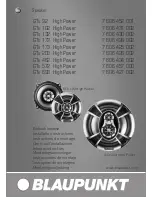
6
Using Your Speakers
If the rest of your system does not work properly or is not correctly connected you will not get the
best performance from your system. To eliminate problems we recommend the following:
I.
Use the finest associated components you can afford. Turntable, cartridges, pre-amps,
amplifiers, (receivers) and cables all have profound impact on the sound of your system.
Accurate speakers let more detail through. You will hear more of the beauty of the music,
but flaws in your system and or source material may be more obvious.
Any good audio system is made up of matched components. You wouldn’t use bargain
recap tires on a new Porshe, and you shouldn’t use inferior components with a high quality
speaker. Your Sapphire XLs perform like speakers costing two to four times their price.
Keep this in mind when selecting the rest of your system.
Your Sapphire XLs will work in systems with as little as 20 watts per channel. But for
optimum sound we recommend high-quality amplification of 35 - 200 watts per channel.
II.
Know your source material. People often blame their audio gear for poor recordings. A
great number of popular recordings are of inferior sound quality. Unfortunately this applies
to records, DVDs and CDs. Commonly poor recordings are rolled off in the low bass, and
harsh and constricted in the mids and highs. Good stereo image is rare. Many recordings
are still done on old studio monitor speakers that are grossly inaccurate. Consider that
some producers still mix recordings to sound best on cheap table and car radios! This
doesn’t mean you can’t enjoy these recordings, but you should try a few of the best
audiophile recordings just to see how terrific your system can be when fed a good signal.
III.
Work at getting the best placement of your speakers in their environment. It is not unusual
to be able to get a 25 to 50 percent improvement in sound by careful placement of
speakers and furniture. It may not be practical to go all out, but the more you can “tune”
your room, the better your system will sound. Refer to the section on placement and room
treatment later in this section.
Avoiding Damage
ACI speakers are designed for the purpose of accurate reproduction of music in the home. We do
our best to make our speakers rugged and reliable. However, ANY speaker or system may be damaged
under certain conditions:
•
Excessive power, particularly at certain frequencies or for prolonged periods of time
•
Excessive distortion often caused by under-powered amplifiers or receivers
•
Defective amplification
•
Excessive subsonic energy
Our systems are tested at high volume levels with a variety of amplifiers and receivers before a
design is approved. With many years of testing, we know it is virtually impossible to damage a component
without the system first giving audible warning in the form of distortion. We also know that true factory
defects are extremely rare, less than one in 10,000 drivers.
Here are some considerations to keep in mind to avoid damaging your drivers:
•
Even though a system may be rated for 100 watts or more it is very easy to damage it with a low power
receiver. When an amplifier runs out of power, it “clips”. This clipping produces large amounts of
distortion which sends excessive energy particularly to the midrange and tweeter. This clipping
distortion accounts for more than 75% of all tweeter failures. How do you know if the amplifier is































